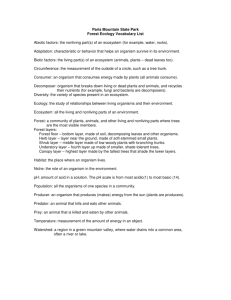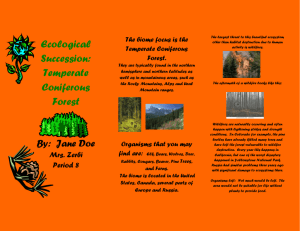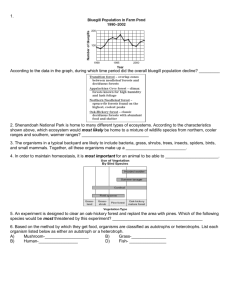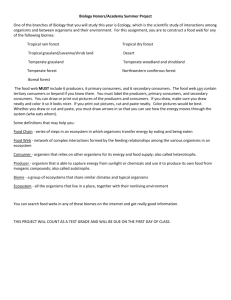Lesson 1 - Talk About Trees
advertisement
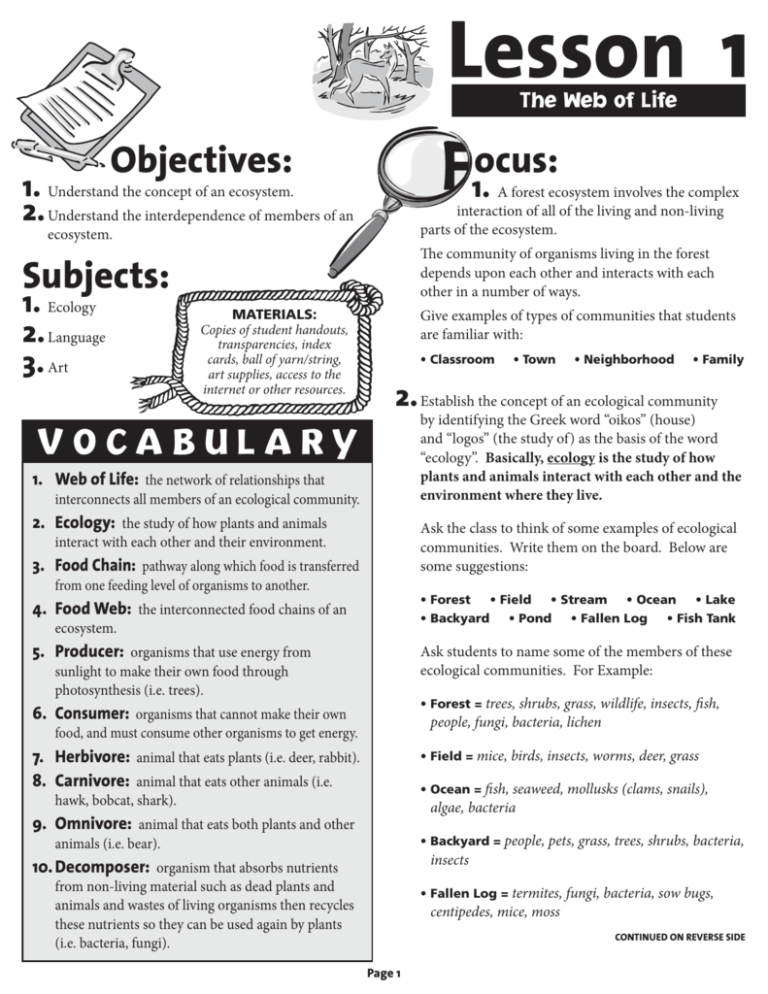
Lesson 1 The Web of Life Objectives: ocus: 1. Understand the concept of an ecosystem. 2. Understand the interdependence of members of an 1. A forest ecosystem involves the complex interaction of all of the living and non-living parts of the ecosystem. ecosystem. The community of organisms living in the forest depends upon each other and interacts with each other in a number of ways. Subjects: 1. Ecology 2. Language 3. Art MATERIALS: Copies of student handouts, transparencies, index cards, ball of yarn/string, art supplies, access to the internet or other resources. Give examples of types of communities that students are familiar with: • Classroom • Town • Neighborhood • Family 2. Establish the concept of an ecological community by identifying the Greek word “oikos” (house) and “logos” (the study of) as the basis of the word “ecology”. Basically, ecology is the study of how plants and animals interact with each other and the environment where they live. VOCABULARY 1. Web of Life: the network of relationships that interconnects all members of an ecological community. 2. Ecology: the study of how plants and animals Ask the class to think of some examples of ecological communities. Write them on the board. Below are some suggestions: interact with each other and their environment. 3. Food Chain: pathway along which food is transferred from one feeding level of organisms to another. • Forest • Field • Stream • Ocean • Lake • Backyard • Pond • Fallen Log • Fish Tank 4. Food Web: the interconnected food chains of an ecosystem. 5. Producer: organisms that use energy from Ask students to name some of the members of these ecological communities. For Example: sunlight to make their own food through photosynthesis (i.e. trees). • Forest = trees, shrubs, grass, wildlife, insects, fish, 6. Consumer: organisms that cannot make their own people, fungi, bacteria, lichen food, and must consume other organisms to get energy. 7. Herbivore: animal that eats plants (i.e. deer, rabbit). 8. Carnivore: animal that eats other animals (i.e. • Field = mice, birds, insects, worms, deer, grass • Ocean = fish, seaweed, mollusks (clams, snails), hawk, bobcat, shark). algae, bacteria 9. Omnivore: animal that eats both plants and other • Backyard = people, pets, grass, trees, shrubs, bacteria, animals (i.e. bear). insects 10. Decomposer: organism that absorbs nutrients from non-living material such as dead plants and animals and wastes of living organisms then recycles these nutrients so they can be used again by plants (i.e. bacteria, fungi). • Fallen Log = termites, fungi, bacteria, sow bugs, centipedes, mice, moss CONTINUED ON REVERSE SIDE Page 1 The forest ecosystem distributes energy to all members of the community. Energy entering the ecosystem as sunlight is transferred by producers into chemical energy made during photosynthesis. This energy is then transferred from one organism to the next through the food web. Plants, the producers of the ecosystem, use sunlight to make energy through photosynthesis. Herbivores are animals that eat plants and carnivores are animals that eat the herbivores. Omnivores eat both plants and other animals. Decomposers break down waste materials and recycle it to a form that can be used again by the plants. This forms a food chain. If we take all of the food chains in an ecosystem and examine their relationships to each other, we have a food web. (See Forest Food Web diagram, p. 6) 3. Teach the concept of interdependence and feedback mechanisms within the community by asking students to brainstorm characteristics that all ecological communities share in common. Examples are given below. As a class, come up with other examples for both your neighborhood and nearby forests. • They all need energy (food) to survive. A plant needs energy from the sun, water, nutrients from the soil, carbon dioxide, and space to grow. Plants also depend upon animals for pollination and seed dispersal. Animals depend on plants for food and shelter. Where do we get our food? Where do we get our clothing and shelter? (Have students trace these back to the actual source—not the store!) • The success of the community depends on the success of the individuals. What would happen to your school if the teachers or students did not attend? (This is an example of interdependence) Page 2 • The success of the individuals depends on the success of the community. What would happen to us if we didn’t have hospitals, water service, schools, law enforcement, grocery stores, etc.? (This is an example of interdependence) • Organisms react to changes within their community. If your local park became very busy on Saturday afternoons, you might choose to go early in the morning instead. If a deer ate all of the grass in an area where it was feeding, it would move to a new area and probably return to the previous area once the food source replenished itself. (This is an example of a feedback mechanism) • The community changes in response to changes by individual organisms within that community. If more people moved into your town, you might see new houses being built in your neighborhood. (This is an example of a feedback mechanism) Activity: • Where specifically do they live in the forest (under a log, in burrows, do they use different parts of the forest? • What do they eat? • What organisms might eat them? • How does it interact with other animals/plants in its community? When something happens to one portion of an ecological community, everything connected to it is affected too. Demonstrate this concept by involving the whole class in one big food web. 1. 3. After your students have finished their cards, take Assign each student to play the role of one member of a forest community. Producers, herbivores, carnivores and decomposers should all be represented. Don’t forget to include a human— humans also live, recreate, hunt, manage and use resources from the forest. them outside and have everyone form a large circle. Have students tape their cards to their shirts so everyone can see the different organisms that are being represented. 2. Give each student an index card with their organism’s name on one side. Instruct them to research and write the following information on the other side of the card: Making the Food Web: 1. 6. Share the following quote by John Muir with the Give the end of the ball of string to one of your producers (plants). students and ask them to interpret it based on what they just saw in the web of life activity. 2. Have the producer hold onto the end of the string and pass the ball to the organism that eats it, then that organism passes it onto another organism that preys upon it. 3. Pass the ball onto a decomposer which recycles waste “When we try to pick out anything by itself, we find it hitched to everything else in the universe.” material nutrients back to the plants. 4. Students should be sharing the information about their organism when the string is passed to them. Continue the process until everyone is interconnected. 5. Have everyone pull gently on the food web to represent the interactions that are taking place in the food web. Ask what would happen if one organism were removed from the food web? Name the other organisms that are affected. What happens if two organisms are removed, etc.? Reinforcement: Reinforce the food web activity back in the classroom by having students complete the Forest Food Web handout (page 6). Page 3 ocus: Community Close-Ups: The number and species of organisms able to survive in an ecosystem depends on the resources that are available. Read the following two scenarios aloud. Have students work in pairs to answer the questions and write a paragraph or make a flowchart to depict what is happening in the communities. COMMUNITY ONE On a hillside in the forest, there is enough water and space to grow 100 healthy trees. Over many years, no forest fires, no insects, no disease, and no harvesting of trees have thinned out or made more room for the growing trees in the area. Now there are 1000 trees competing in this area that only has enough sunlight, water, nutrients and space for 100 trees. 3. What could happen to a forest 1. 4. Can humans do anything to Is this a healthy forest? No, the trees are stressed because they are not all able to get enough of the resources they need to fight off insect attacks, disease, and to grow into large trees. Also, these trees are less likely to survive a forest fire because they are growing so closely together, the fire will easily spread from one tree top to the next. that has many diseased and dead trees? This forest is more susceptible to an intense forest fire that would kill all of the trees and degrade the watershed and wildlife habitat. 2. What will eventually happen to many of the stressed trees? They will continue to weaken and will likely die. Page 4 restore this forest to a healthy ecosystem? Yes, forest managers are trained to use a variety of methods for managing healthy forests. We could harvest the overcrowded trees to make room for other trees to grow large and thrive. The trees that are harvested will go to a sawmill to be made into many renewable wood products such as lumber for homes, paper, furniture, cleaning products, cosmetics, etc. Forest managers must protect wildlife habitat, water quality, and ensure the sustainability of future forests before they are allowed to harvest any trees. COMMUNITY TWO An area of the forest has lots of small shrubs and seedlings. It has very few large trees. It is a perfect home for mice. Since owls love mice, this is also a good hunting ground for owls. Over time the seedlings and saplings in this area grow into older, taller trees and shade the forest floor from the sun. They compete successfully for sun, water, and nutrients (food) and suppress the shrubs, grasses and seedlings trying to grow in this area. 1. 4. What happens if some of the trees are harvested? The trees that remain will be healthier. More sun, water, and nutrients will reach smaller plants as pockets of the forest are opened up. The smaller plants will bring back the mice. The return of the mice will bring their predators, like the owls, back into the area. What happens to the mice as shrubs, grasses and seedlings disappear? They find new homes in other areas that provide more food and safety. 2. What happens to the owls? They will need to hunt in other areas where they will be able to find mice. 3. What will happen to the trees if they become overcrowded? They become stressed and are more likely to die of disease, insect attacks and fire. Enrichment Activity: Build a food web mobile. Students can use the organism that they researched for the food web activity. Use construction paper and/or index cards to make cutouts of the featured organism and all of the other organisms it interacts with in its environment. Use string to tie the cutouts to coat hangers. Page 5 Forest Food Web: This food web represents all of the interconnected feeding relationships in the forest ecosystem. Complete the food web by drawing pictures or writing the names of other organisms in the boxes. • Indicate whether the organism is a producer, carnivore, omnivore, herbivore or decomposer. • Draw arrows pointing to the organism that is consuming the energy from another organism. Page 6
